HOME > EXHIBITIONS > KOTA OKUDA
TOP | EXHIBITION VIEW | INTERVIEW | ABOUT
Kota Okuda
Butterfly Effect
November 10th – December 4th, 2022
Opening Reception:
Thursday, November 10th, 6-8pm
Another day, another dollar
What is a dollar worth today? What would you buy if you had but one dollar to your name? Even the dollar store doesn’t carry only things that cost a dollar. The one-dollar bill is the lowest and the humblest denomination. But it is also the foundational denomination, the single unit to which all the others break down.
Kota Okuda examines the one-dollar bill in minute detail in his work. He blows it up, prods and pokes at it, reconfigures and recontextualizes it. The symbolic value of currency—these pieces of paper that occupy our minds and lives—fascinates Okuda, and it always has.
The one-dollar bill represents near misses (“a day late and a dollar short”), reliability and steadfastness (“as sound as a dollar”), value in not just monetary but metaphorical terms (“bang for your buck”), desperation (“anything for a dollar”), and even holiness—though usually ironically (“the almighty dollar”). It is a potent, charged, malleable symbol, and perhaps more than anything else it represents cold, hard reality at its basest (“the buck stops here”).
In Okuda’s treatment of the one-dollar bill, in his manipulation of the many elements that comprise it, we are forced to reconsider our preconceived notions about money and its power—as well as its aesthetics. Okuda not only draws out questions regarding economics; he also plays with the pure, arcane, Masonic beauty of the dollar. From its portrait of America’s favorite founding father, to its ominous Latin texts, to the uncanny spookiness of the all-seeing eye and the dense webbing of the bill’s background, Okuda manipulates the familiar until it becomes new again. If only the global value of the dollar itself could be so manipulated.
Okuda’s work in this exhibition is also about the elusive nature of causality. How can one small change—and, for most of us, a dollar is merely that: change—impact the world at large? How can the whispering of a butterfly’s wings lead to a gust of wind on the other side of the world?
There are almost 13 billion one-dollar bills in circulation today. That’s almost 13 billion last chances and fresh starts. 13 billion pairs of butterfly wings that, with one small flap, can echo in both creative and destructive ways.
EXHIBITION VIEW
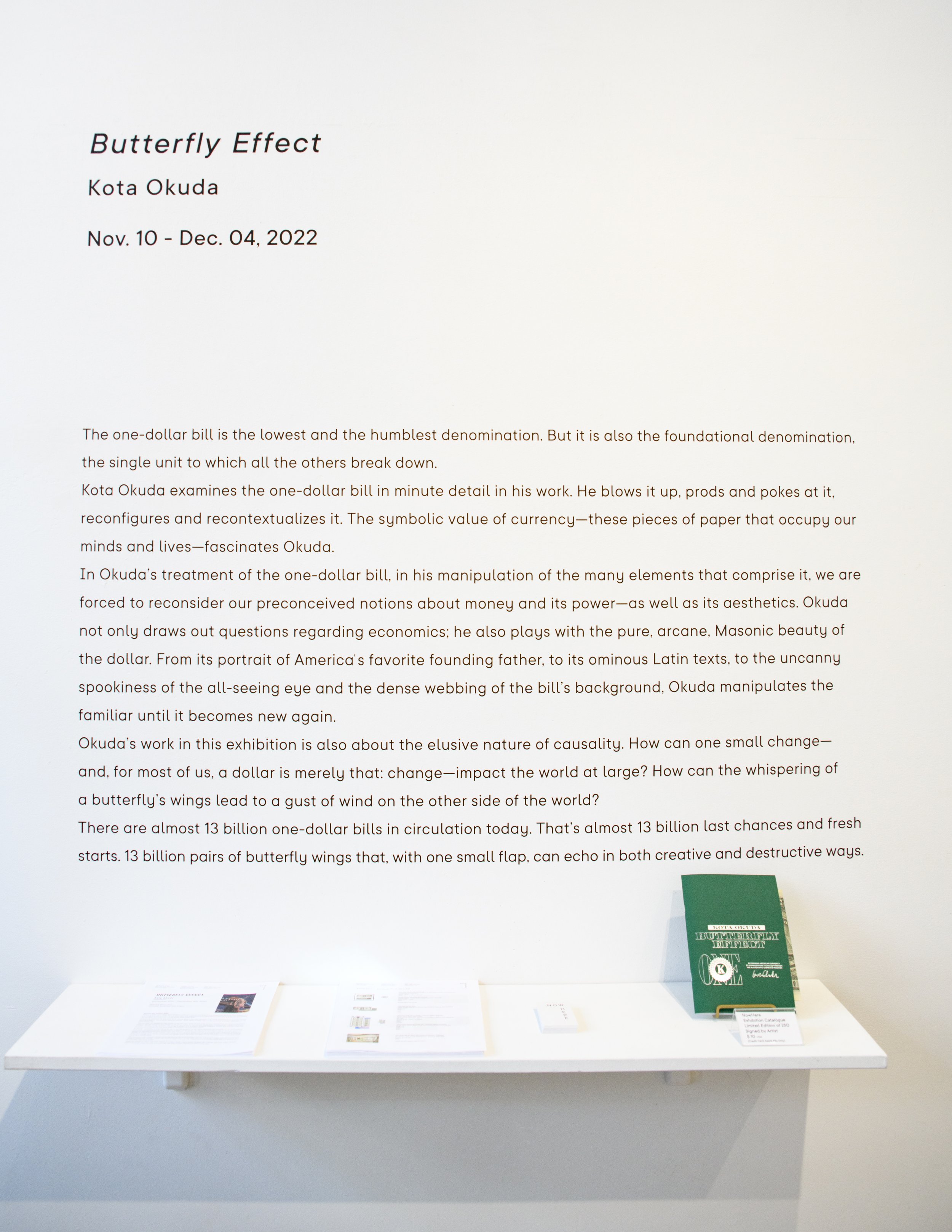

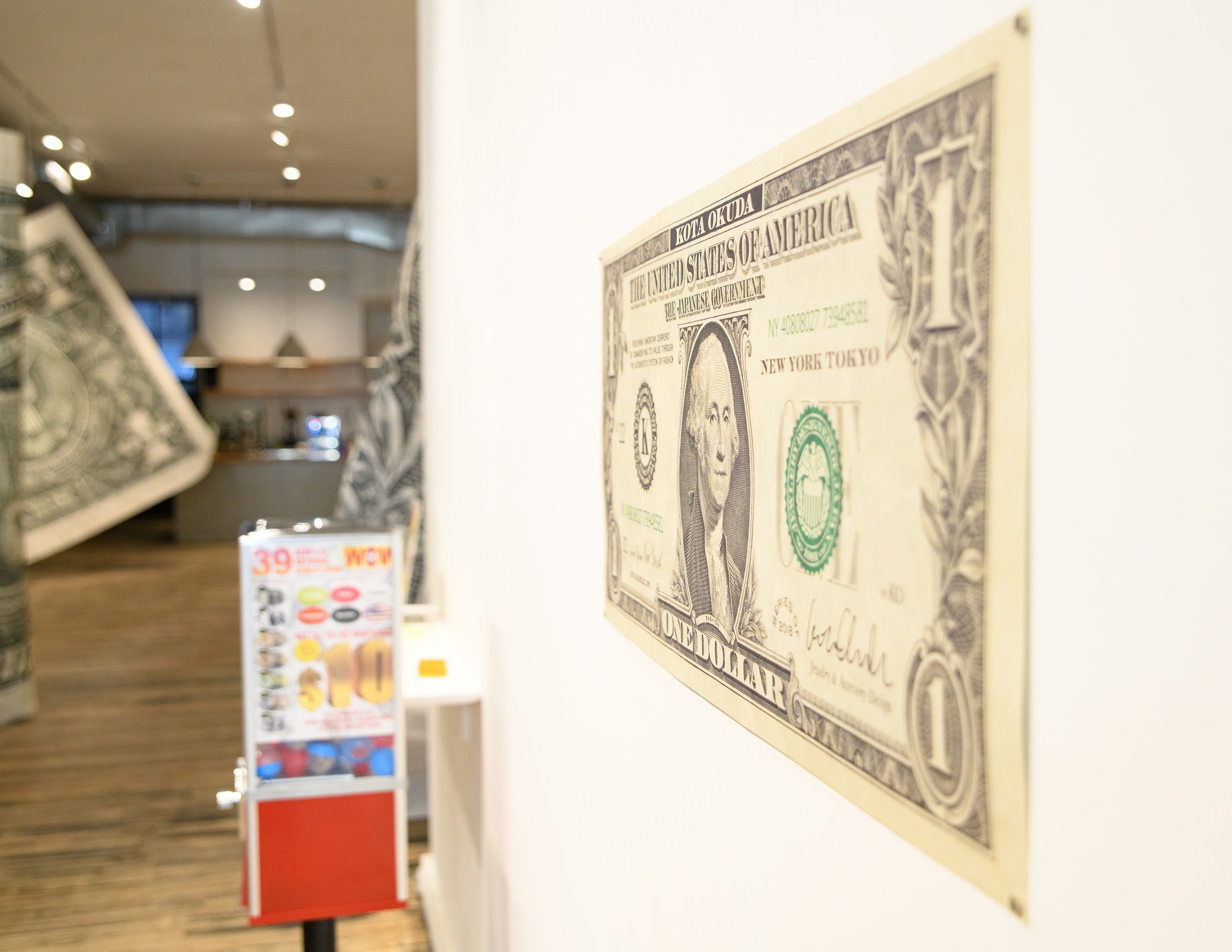
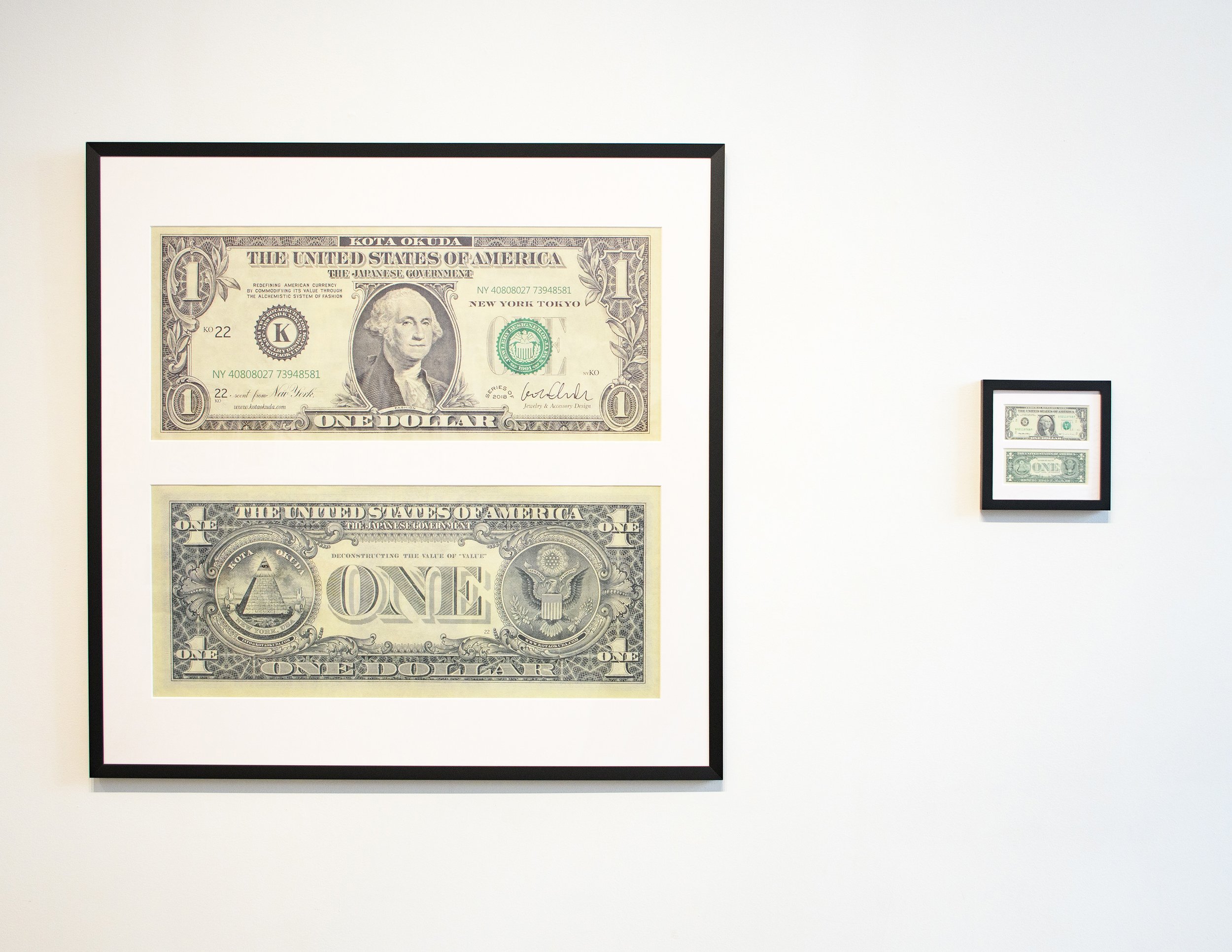
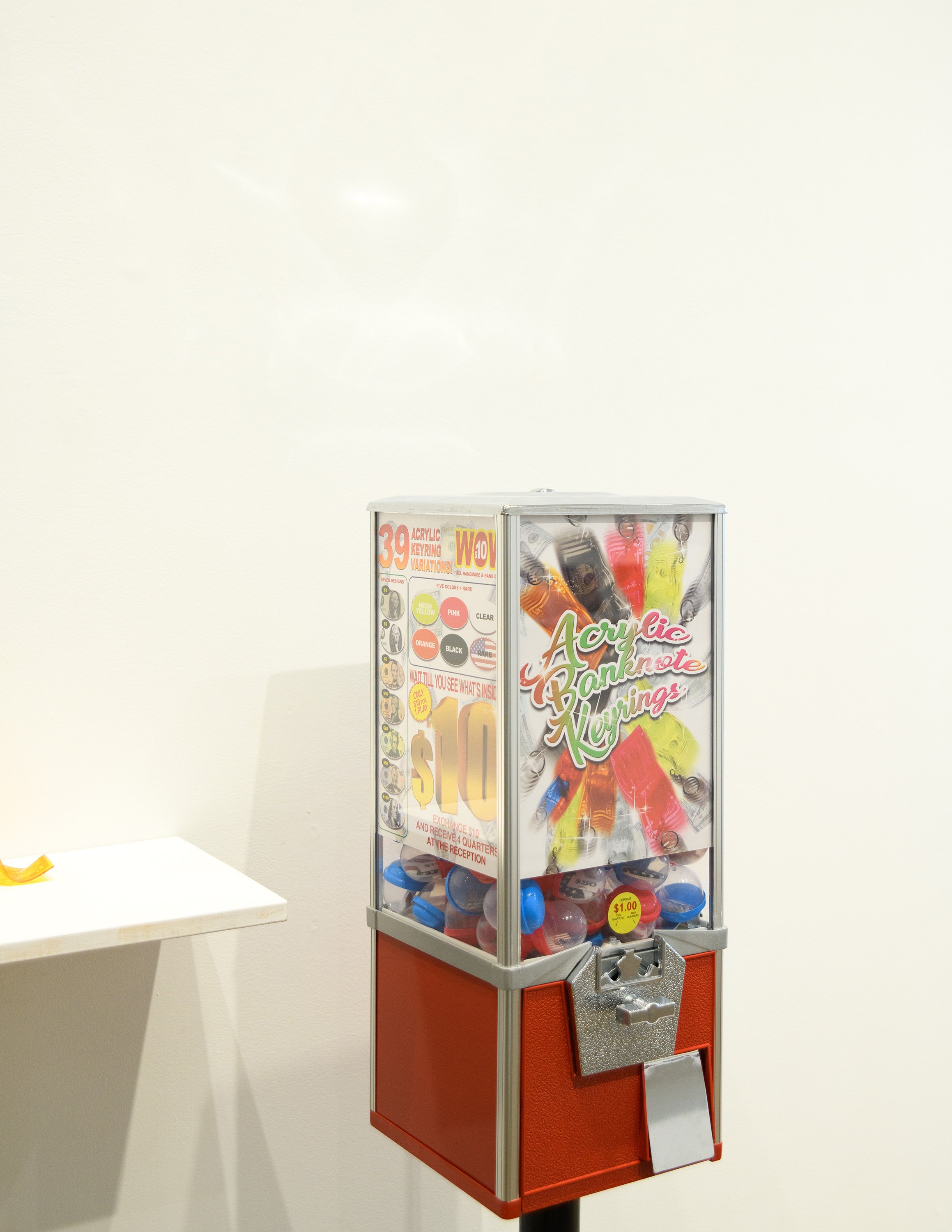


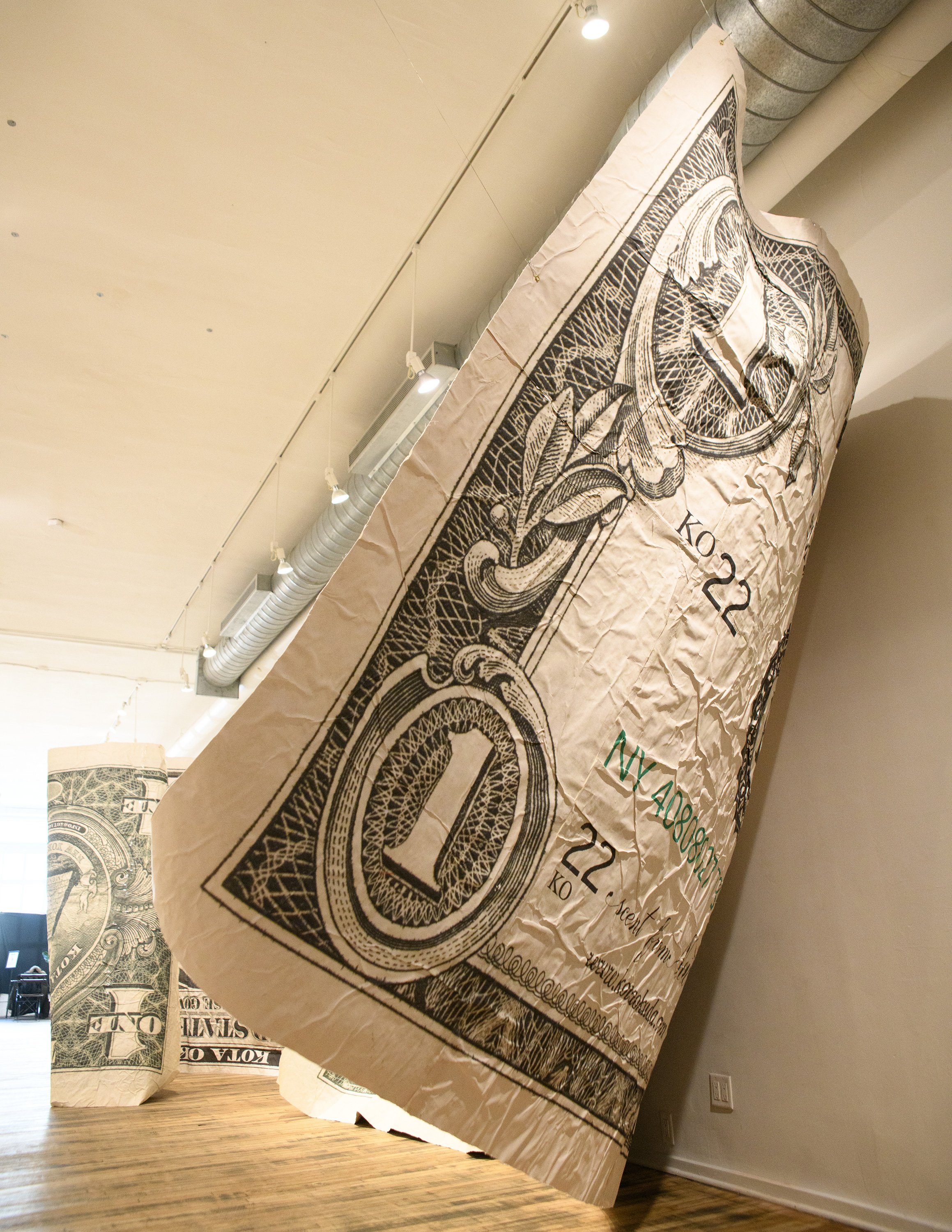
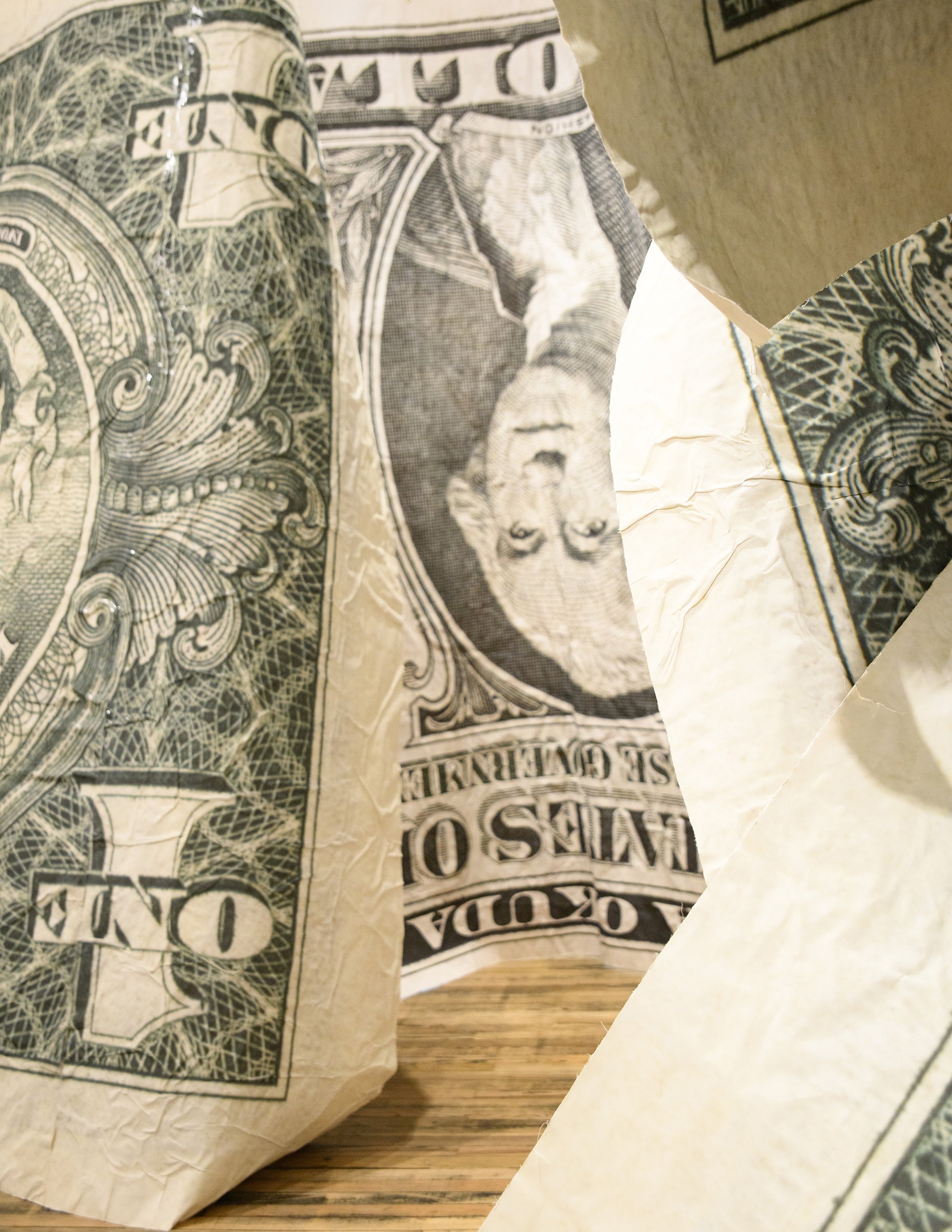

INTERVIEW
AN UNREMARKABLE OBJECT
– An interview with Kota Okuda
What are your favorite parts of the one-dollar bill on a purely aesthetic level?
There’s the iconic portrait of George Washington, the beautiful vignette engraving, the guilloche patterns, the symbolic numerals, the mottos, the historical motifs and inscriptions…
That’s a lot.
There is so much to see in this “unremarkable” object. And the most remarkable fact is that the one-dollar bill is engrained across the world in people’s minds as the U.S. currency. Because of its worldwide circulation, people can easily distinguish this bill when comparing it with other countries’ banknotes.
It’s a symbol of America that travels the world.
The American one-dollar bill evokes and connects deeply between country (identity) and currency. I believe this makes it the ultimate design.
I’m interested in the idea of giving the viewer a sense of “discomfort and wonder” as you’ve written in this show’s statement. What do you mean by discomfort in this context?
Once the motif of a dollar bill has been changed by me—whether it is metamorphosed in scale, in design, or in material, the viewer will pay a different kind of attention toward the original object and compare it with my new version in their mind. It will be a shock to the viewers’ unconscious imagination.
How do you define the term “butterfly effect”?
A very small change in initial conditions that creates a significantly different outcome. The idea that small causes may have large effects in events.
If I gave you one dollar and asked you to spend it today, what would you buy with it?
I would visit a bank and exchange it for one hundred pennies, then I’d make accessories from them. I like the act of exchange itself.
How do you interpret the text of the Great Seal on the back of the dollar (E Pluribus Unum or "Out of many, one")? What does that mean to you?
It represents to me elements of power, authority, magnificence, hardness, and strength.
Are you a person who carefully saves money? Or do you spend it recklessly?
I am not a person who carefully saves money, but I don't spend it recklessly either.
What do you spend money on?
I am a collector of a specific genre of rare books, and I often buy those and archival magazines—especially fashion, art, crafts, and photography publications. It is important for me to accumulate visual archives.
What about the other senses as they apply to the one-dollar bill? What are your thoughts on the way the bill feels in your hands or the way it smells?
Smell is one of the most important senses. We forget most of what we see and hear, but not the things we can actually touch and smell. So I make sure I can see the image of the banknote almost every day; I am always into them.
In terms of tactility, would you rather have a crisp new dollar or a soft, worn dollar?
A worn dollar might give us an anonymous story, and so it could have a sense of additional value. Where does it come from? Who had it before us? When was it made? But, of course, with a new dollar one can enjoy the feeling of the paper and the fresh printing smell.
Do you still use cash frequently? Most people use cards or even Apple Pay now. Is cash an endangered species?
Yes, I do. Of course, I use credit cards for most shopping but I value using and having cash too. I do not want to forget the feeling of weight and I enjoy observing the design. Currency is one of the biggest innovations for civilization. It allows people to participate in social activities with peace of mind. I do think cash is an endangered species and a completely cashless world might blur the borders of nationality, patriotic identity, and cultural contexts.
Kota Okuda
Kota Okuda studied Jewelry Design at Central Saint Martins in London. He received his MFA in Fashion Design and Society at the Parsons School of Design. Okuda made his New York Fashion Week debut in A/W 2018, and his following show became a trending topic during New York Fashion Week S/S 2019. His work has appeared in Paper, Office, Novembre, Notion, and Schon! magazines and the New York Post.
Okuda’s fundamental creative focus is on combining traditional handcraft processes with emergent digital technologies such as 3D modeling and printing. Okuda’s self-stated mission is to expand the imagination and possibility of jewelry design. A significant focus of Okuda’s design process lies in considering how a piece of jewelry might interact with the human body. At the same time, he explores the various possibilities of the relationship between jewelry and fashion.
This hybridization of fine art, fashion, and applied craft fascinates Okuda, whose work addresses concerns of significance, purpose, value, materiality, scale, and perfor- mance. Okuda takes great pleasure in investigating the history and context behind contemporary jewelry, art, and fashion. His aesthetic, while deeply of-the-moment with its accessible sense of humor, also contains classical and antique elements.
ABOUT
Relative Contents
Kota Okuda
Butterfly Effect
$15.00
Kota Okuda
$17 76¢
February 7 – March 15, 2020
Kota Okuda
$17 76¢
$15.00




